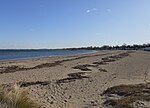John Halloran House
1910 establishments in MassachusettsColonial Revival architecture in MassachusettsHouses completed in 1910Houses in Quincy, MassachusettsHouses on the National Register of Historic Places in Norfolk County, Massachusetts ... and 2 more
National Register of Historic Places in Quincy, MassachusettsNorfolk County, Massachusetts Registered Historic Place stubs

The John Halloran House is a historic house at 99 E. Squantum Street in Quincy, Massachusetts. This two-family wood-frame house was built in 1910 for John Halloran, a local police officer. It is a well-preserved Colonial Revival example of duplexes that were commonly built in the Atlantic neighborhood of Quincy, with a fine balustraded porch, and an entrance with long sidelight windows and oval window in the door. Bay windows project on the right side of the front, and a low hip-roof dormer projects from the roof.The house was listed on the National Register of Historic Places in 1989.
Excerpt from the Wikipedia article John Halloran House (License: CC BY-SA 3.0, Authors, Images).John Halloran House
East Squantum Street, Quincy North Quincy
Geographical coordinates (GPS) Address Nearby Places Show on map
Geographical coordinates (GPS)
| Latitude | Longitude |
|---|---|
| N 42.278888888889 ° | E -71.026111111111 ° |
Address
East Squantum Street 99
02171 Quincy, North Quincy
Massachusetts, United States
Open on Google Maps








